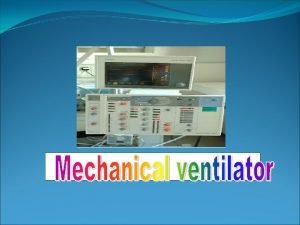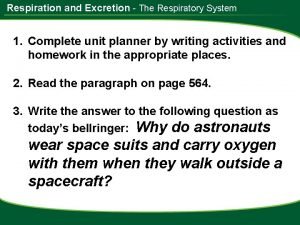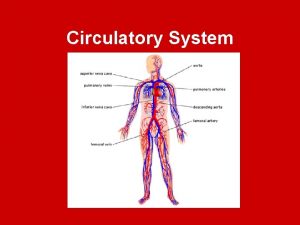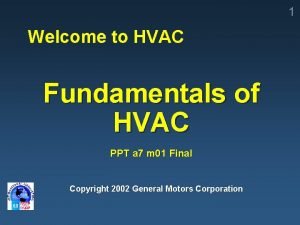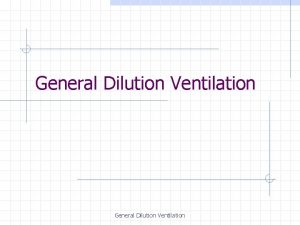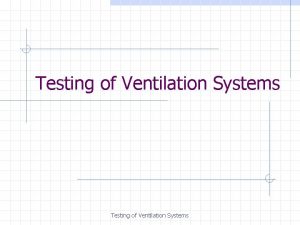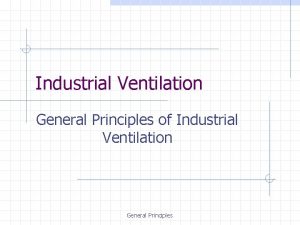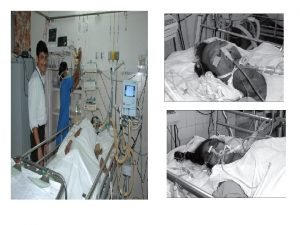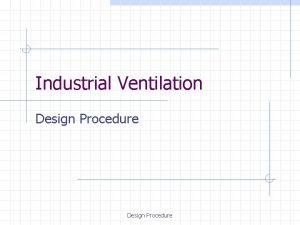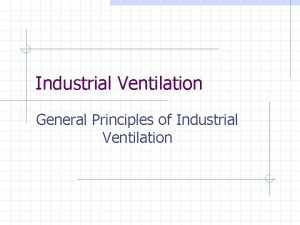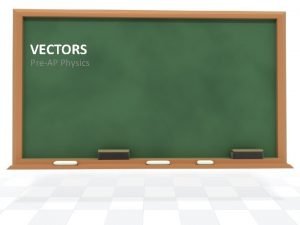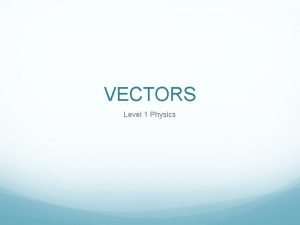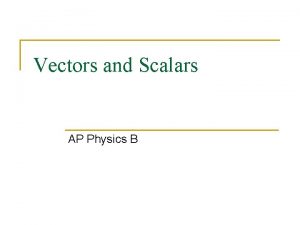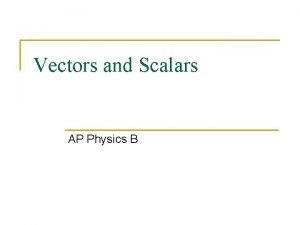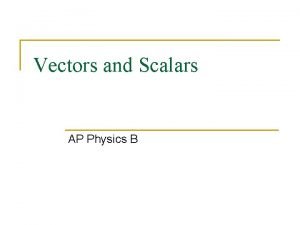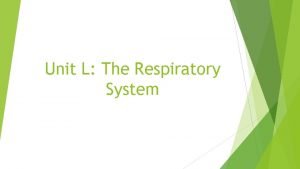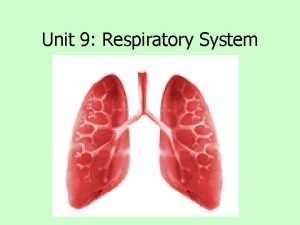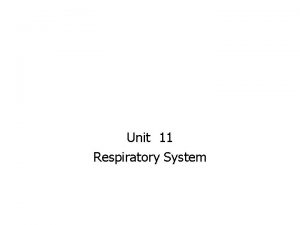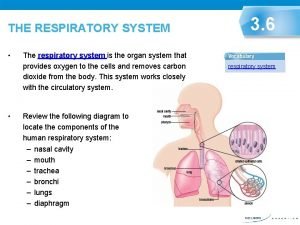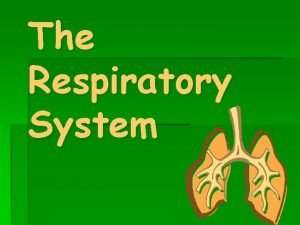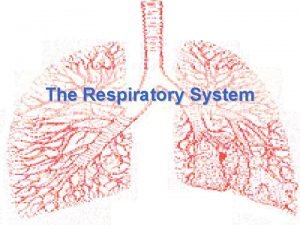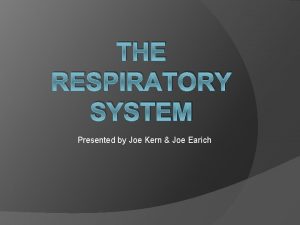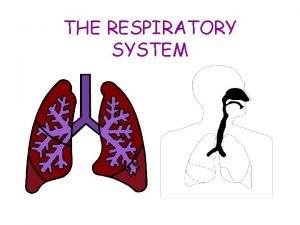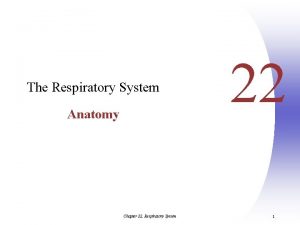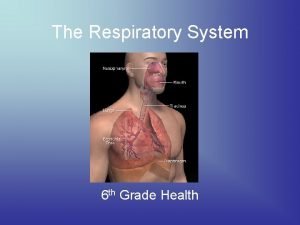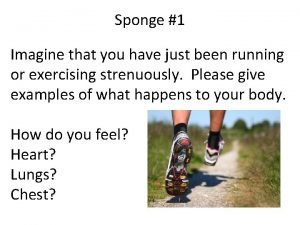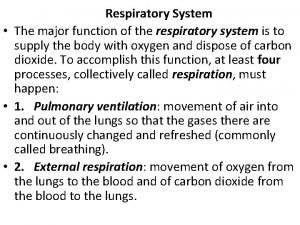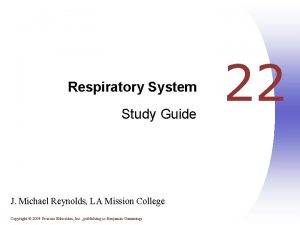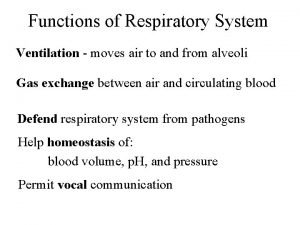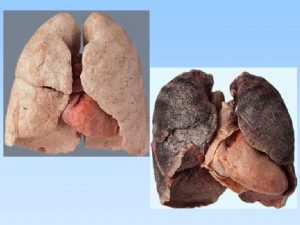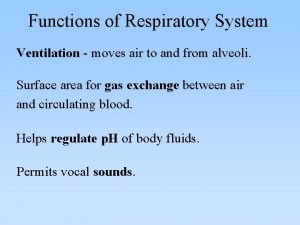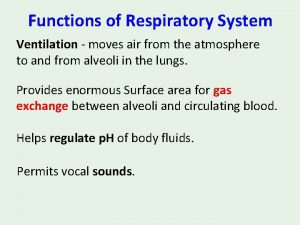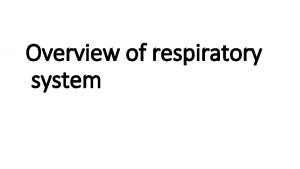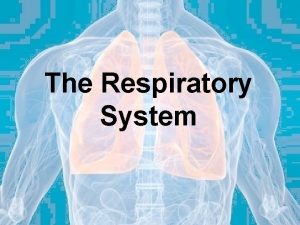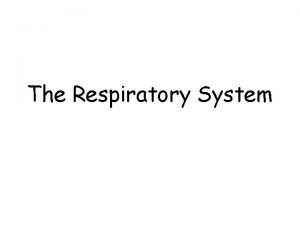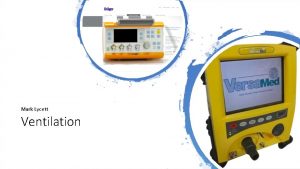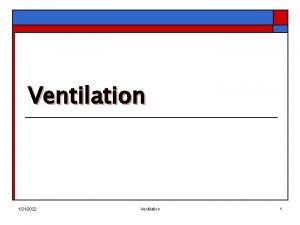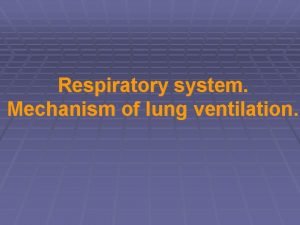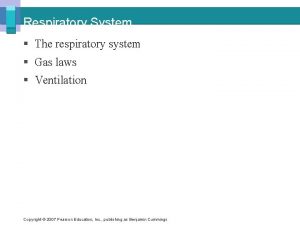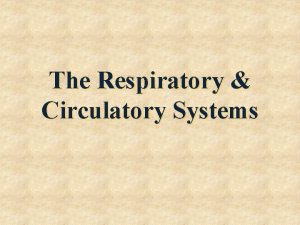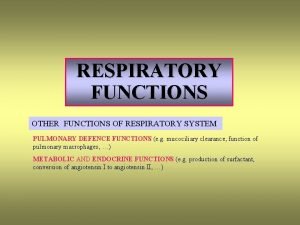Functions of Respiratory System Ventilation moves air to








































- Slides: 40

Functions of Respiratory System Ventilation - moves air to and from alveoli Gas exchange between air and circulating blood Defend respiratory system from pathogens Help homestasis of: blood volume, p. H, and pressure Permit vocal communication

Respiration • Ventilation- environment and lungs • External Respiration – alveoli and blood • Internal respiration – Blood and cells • Cellular Respiration – Biochemical inside cell

Respiratory organs Nose, nasal cavity, and paranasal sinuses Pharynx, larynx, and trachea Bronchi and smaller branches Lungs and alveoli • Divided into: – upper – lower

External nares

• Upper respiratory system – Nose – Nasal cavity – Pharynx • Functions • Warm, Filter and Humidify incoming air • Lower Respiratory System • Larynx • Trachea • Bronchioles • Alveoli

The Nose • Provides an airway for respiration • Moistens and warms air • Filters inhaled air • Houses olfactory receptors


PARANASAL SINUSES

Respiratory Epithelium. • Lines conducting portions • Pseudostratified ciliated columnar epithelium with goblet cells PSCC – Produces mucus to trap foreign particles

Respiratory Epithelium.

cilia rhythmically ‘sweeps’ debris up to be swallowed or expelled at pharynx • • Mucus escalator Alveolar macrophage Hairs in nose Cilia - lining respiratory tract

• External nares – Open into nasal cavity – Vestibule guarded by hairs • Nasal cavity – Superior, middle and inferior meatuses • Narrow grooves and conchal surfaces • Hard palate – Nasal and oral cavities • Soft palate – Superior nasopharynx and pharynx • Internal nares – Between nasal cavity and nasopharynx

The Pharynx Shared by digestive and respiratory systems Nasopharynx Superior portion: from internal nares to uvula. Oropharynx Continuous with oral cavity Laryngopharynx Between hyoid and entrance to esophagus

Nasopharynx • • Superior to the point where food enters Only an air passageway Closed off during swallowing Pharyngeal tonsil (adenoids) – Located on posterior wall – Destroys entering pathogens • Contains the opening to the auditory tube

Oropharynx • Extends from soft palate to the epiglottis • Epithelium is stratified squamous epithelium • Two tonsils in the oropharynx – Palatine tonsils – in the lateral walls – Lingual tonsils – covers the posterior surface of the tongue

Laryngopharynx • Passageway for both food and air • Lined with stratified squamous epithelium • Continuous with the esophagus and larynx

The Lower Respiratory System • Surrounds glottis - air passes through glottis to reach lungs • Epiglottis - prevents solids from entering respiratory system Larynx

During swallowing, elevation of the larynx folds epiglottis over the glottis, steering materials into the esophagus.

Trachea • Submucosa includes “C” rings of cartilage – Tracheal cartilages – Stiffen tracheal walls and protect airway – Posterior wall distorts allowing food passage through esophagus



Left and Right 1 o Bronchi • Right and left primary bronchi – Trachea branches within mediastinum • Bronchial tree – Enters lungs at hilus • Root of lung – Bronchus, primary vessels, nerves • Bronchial tree – extensively branching respiratory passageways • Primary bronchi (main bronchi) – largest bronchi • Right main bronchi – wider and shorter than the left

Lungs • Right lung has three lobes • Superior lobar, middle lobar and inferior lobar bronchi • Left lung has two lobes • Superior lobar and inferior lobar bronchi • Cardiac notch



• Secondary (lobar) bronchi – Three on the right – Two on the left • Tertiary (segmental) bronchi – Branch into each lung segment • Bronchioles – little bronchi, less than 1 mm in diameter • Terminal bronchioles – less than 0. 5 mm in diameter


Bronchi and Bronchioles

• For clarity, the degree of branching has been reduced: an airway branches approximately 23 times before reaching the level of a lobule.

Fig 24. 11

Alveolus – cells and composition 1. Simple squamous epithelium (type I) 2. Septal cells (type II) Produce surfactant 3. Alveolar macrophages (dust cells) Patrol epithelium Engulf foreign particles

Basic structure of a lobule, cut to reveal the arrangement between the alveolar ducts and alveoli.

Respiratory Membrane • Respiratory Membrane (blood-air Barrier) • “point of gas exchange” • Aveolar Epithelium simple squamous epithelia • Fused basement membrane Capillary endothelium simple squamous epithelia

Respiratory Epithelium • • • • Air epithelia tissue Nasal cavity stratified squamous Nasopharynx PSCC Oropharynx stratified squamous Laryngopharynx stratified squamous Larynx PSCC Trachea PSCC Rt. /Lt. primary bronchi PSCC Secondary (lobar) bronchi. PSCC Tertiary (segmental) bronchi PSCC Terminal bronchioles simple cuboidal Respiratory bronchioles simple cuboidal Alveolar duct simple squamous Alveolar sac simple squamous Alveolus simple squamous

Ep=pscc Sumb=tunica submucosa Cart=tracheal ring Adv=tunica

Respiratory Muscles Ventilation - movement of air into and out of lungs.

Eupnea - normal quite breathing at rest. Inspiration: volume of thoracic cavity. Muscle activity required: Diaphragm External Intercostals Sternocleidomastoid

When Forcefully exhaling (hypereupnea): Muscles used: Internal Intercostals Rectus abdominis Transverse abdominis, Internal and External obliques.

• Bronchial asthma – a type of allergic inflammation – A hypersensitivity to irritants in the air or to stress – Asthma attacks characterized by: • Contraction of bronchiole smooth muscle • Secretion of mucus in airways • Chronic obstructive pulmonary disease (COPD) – Airflow into and out of the lungs is difficult • Obstructive emphysema • Chronic bronchitis – History of smoking

• Cystic fibrosis (CF) – inherited disease – Exocrine gland function is disrupted – Respiratory system affected by: • Oversecretion of viscous mucus • Epistaxis – nosebleed • Epiglottitis – inflammation and swelling of the epiglottis • Dyspnea – difficulty in breathing • Apnea – cessation of breathing
 Mechanical ventilation modes
Mechanical ventilation modes Conducting zone respiratory
Conducting zone respiratory Digestive system circulatory system and respiratory system
Digestive system circulatory system and respiratory system Respiration
Respiration Draw the flowchart of respiratory system
Draw the flowchart of respiratory system Pathway of air in respiratory system
Pathway of air in respiratory system 5 functions of the respiratory system
5 functions of the respiratory system Air higroskopis air kapiler dan air gravitasi
Air higroskopis air kapiler dan air gravitasi Introduction to hvac systems ppt
Introduction to hvac systems ppt How respiratory system work with circulatory system
How respiratory system work with circulatory system Circulatory system and respiratory system work together
Circulatory system and respiratory system work together Trachea and windpipe
Trachea and windpipe Dilution ventilation equation
Dilution ventilation equation Ventilation system testing
Ventilation system testing General exhaust ventilation
General exhaust ventilation Normal ag
Normal ag Industrial ventilation calculation
Industrial ventilation calculation Industrial ventilation calculation
Industrial ventilation calculation A bear searching for food wanders 35 meters east
A bear searching for food wanders 35 meters east A storm system moves 5000 km due east
A storm system moves 5000 km due east 700 calories scalar or vector
700 calories scalar or vector A storm system moves 5000 km due east
A storm system moves 5000 km due east A storm system moves 5000 km due east
A storm system moves 5000 km due east Ap physics vector problems
Ap physics vector problems Bozeman respiratory system
Bozeman respiratory system Unit 9 respiratory system
Unit 9 respiratory system Diagnostic test of respiratory system
Diagnostic test of respiratory system What is the respiratory system
What is the respiratory system Cuneiform cartilage
Cuneiform cartilage Respiratory system coloring page
Respiratory system coloring page Respiratory system purpose
Respiratory system purpose Respiratory system conclusion
Respiratory system conclusion Jobs of respiratory system
Jobs of respiratory system The human respiratory system chapter 7 handout
The human respiratory system chapter 7 handout Chapter 13 the respiratory system
Chapter 13 the respiratory system Perfusion respiratory
Perfusion respiratory Interesting facts about respiratory system
Interesting facts about respiratory system How to draw the respiratory system
How to draw the respiratory system What is the major function of the respiratory system
What is the major function of the respiratory system Respiratory system diagram unlabeled
Respiratory system diagram unlabeled Respiratory system vocabulary
Respiratory system vocabulary
